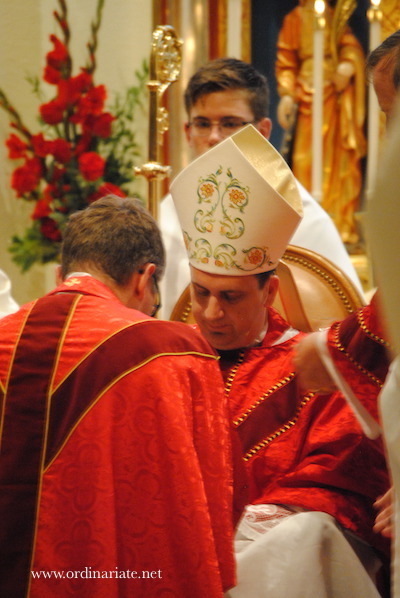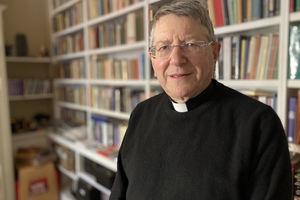English-Catholic Ordinariate Sees New Opportunities for Grace and Growth
Ordinariate communities expanded in 2017 as laymen and women take charge and evangelize, supported by their priests and bishop.

WASHINGTON — When Father John Vidal arrived to take charge of the St. Luke’s ordinariate parish in the nation’s capital in October, the community had been without a pastor for three months.
But rather than discover a church on hold, waiting for its new clerical leadership, the Catholic priest discovered a ordinariate community that had continued to grow.
“The lay leadership kept the congregation not only growing, but thriving,” Father Vidal told the Register.
While a priest on loan from the Archdiocese of Washington offered the English-Catholic ordinariate’s form of the Roman missal, Divine Worship, the all-volunteer staff of St. Luke’s helped another person enter the Catholic Church through catechism classes, arranged beautiful musical services of “Lessons and Carols” and organized a parish pledge drive.
Most Catholic parishes, Father Vidal said, consider themselves blessed to have 20% of the parishioners actively involved in building up the church. But he said “easily half” of his parish are active in building up the church.
“They don’t just come to Mass; they’re very involved at the lay-level in every aspect of the community,” he said. “I find that refreshing and exciting.”
The Personal Ordinariate of the Chair of St. Peter is the diocesan home of the English-Catholic tradition in the U.S. and Canada, born of the combined efforts of Benedict XVI and Pope Francis to restore the English spiritual patrimony to the Catholic Church. Benedict created the special diocese, known as a “personal ordinariate,” in response to Anglican groups that wanted to reunite with the Catholic Church but maintain their distinctive patrimony, the English liturgical and spiritual practices that had developed within Anglicanism for the past 500 years.
Pope Francis in 2015 approved a new Roman missal for the ordinariate based entirely on the English liturgical tradition, called Divine Worship, expanded its missionary mandate and named its first bishop: Steven Lopes, an American who had worked closely on setting up the ordinariate and Divine Worship in the Congregation for the Doctrine of the Faith.
Father Vidal said St. Luke’s continues to grow, creating the good kinds of challenges that Catholic pastors would like to have.
At the moment, the ordinariate congregation shares space with Immaculate Conception Catholic Church in Washington. Father Vidal said the relationship has been enriching, but their growth means they have to start a serious capital campaign that will allow the parish to have its own church building and facilities to aid adult-education activities and outreach programs.
Many Milestones
The growth and future of the ordinariate, and its 45 parishes in the U.S. and Canada, depends on the active collaboration of its clergy and lay faithful to go forth, evangelize and invite people into the Catholic Church through the restored English spiritual patrimony and liturgical tradition.
The ordinariate met many milestones in 2017. Bishop Lopes issued his own pastoral letter on Amoris Laetitia, called “A Pledged Troth,” and consecrated his English-Catholic diocese to the Immaculate Heart of Mary to coincide with the 100th anniversary of Our Lady of Fatima’s apparition. He ordained the first celibate seminarian to the priesthood, Father Evan Simington, assigned to the Fellowship of St. Alban, in Rochester, New York. He also formally welcomed the Dominican Sisters of Mary, Mother of the Eucharist, to carry out their teaching mission for the ordinariate in Texas.
The year saw Pope Francis formally decree the end of “pastoral provision” parishes — parishes formed from groups of Anglican and Episcopalian converts that entered the Church decades before the ordinariate was formed and who belonged to a local diocese.
Pope Francis made the decision as part of an instruction that Our Lady of the Atonement, the first pastoral provision parish in the U.S., be transferred entirely from the jurisdiction of the Archdiocese of San Antonio to the ordinariate.
The ordinariate established three more communities: Our Lady and St. John Catholic Community in Louisville, Kentucky, St. Aelred Catholic Community in Athens, Georgia, and Holy Martyrs of England and Wales Catholic Church in Southwest Riverside County, California.
Lay Leadership Key
The ordinariate is small and trying to meet the spiritual needs of its members while strengthening itself for the future.
The ordinariate saw further roots set down, with the formal consecration of Mount Calvary Catholic Church in Baltimore, Maryland, and St. Barnabas Catholic Church in Omaha, Nebraska.
Father Jason Catania, pastor of St. Barnabas, told the Register that his ordinariate parish’s growth has been helped by its partnership with Chesterton Academy of Omaha, the local Catholic radio station, a “good, effective use of Facebook,” and specific events in the life of the local Catholic Church.
“We’ve been seeing some steady growth, especially since the summer,” he said. The parish plans on building an addition to facilitate access for those with disabilities and completing the parking lot to accommodate the growing number of Catholics worshipping at the parish.
Even with its overall growth, the ordinariate ended up suppressing one community, St. Anselm’s in Corpus Christi, Texas, in September 2017 after deeming it no longer viable.
Father Timothy Perkins, the vicar general for the Personal Ordinariate of the Chair of St. Peter, told the Register the ordinariate is continuing to learn from its beginnings, while working to establish the financial support and organizational structures to support its future growth. Since the ordinariate is new, he said, the focus is on stabilizing parishes and integrating them into the broader life of the Catholic Church.
No small part of that success comes from the discipleship and evangelizing ministry of its lay members.
Aaron McGarvey, an instituted acolyte (who assists at services) at Incarnation Catholic Church in Orlando, Florida, said the ordinariate parish experienced “a very busy year.” He said parishioners are aiming to expand the altar server guild, parish choir, the Legion of Mary, and Secular Third Order Franciscans, in addition to the Knights of Columbus council.
For the past two years, Bishop Lopes has instituted acolytes at parishes, both to provide a source of stable lay leadership, but also to make “Solemn Mass” more widely available, with the sacred ministers of priest, deacon and subdeacon, as intended by Blessed Paul VI.
Although Blessed Paul VI removed the subdiaconal ministry from the major orders with his 1972 apostolic letter Ministeria Quaedam, the Holy Father intended to restore the subdiaconal role to laymen, who could assist the deacon in the life of the local Church, particularly at the altar.
This kind of lay ministry had been preserved practically in the Church in England, since before the Reformation. Acolytes, sometimes called lay clerics or lay clerks, would help lead morning or evening prayer, or attend to the upkeep of the parish, and the role would tend to be taken up by sons who learned it from their fathers.
St. Barnabas’ Father Catania said instituted acolytes have been a source of leadership in his parish, and he is discerning whether any might have a vocation to the diaconate. Having a permanent deacon in the parish, he said, would help the parish have a Solemn Mass every week.
Since Incarnation in Orlando had McGarvey and another layman instituted acolytes by Bishop Lopes in September, McGarvery said they have had approximately a half-dozen Solemn Masses in the ordinariate form. His role has also been a “fantastic evangelization tool” for sharing the faith with his non-Catholic friends. Occasionally, a friend will tell him that the ordinariate Solemn Mass looks a lot like Catholic Masses from old black-and-white movies.
And his closeness to the Mass, and to the priests on the altar, has given him a “new perspective” on the communal prayer of the Church.
“It is an experience I don’t think I will ever get over, or take for granted,” he said.
Evangelization Startups
The ordinariate is also seeing a number of “startup” communities, called “Anglican Patrimony Groups,” organize all over the country, in the hopes of someday formally joining the ordinariate. These groups may be comprised of laymen and women, who are current or former Anglicans, Episcopalians or Methodists, as well as lifelong Catholics, who gather together at least monthly for fellowship and for praying an ordinariate-approved form of the Daily Office, but attend Mass at other Catholic parishes until they become a recognized ordinariate community.
“These are startup groups that are organic,” explained Shane Schaetzel, an executive board member of the Anglicanorum Coetibus Society, adding the process could take months or years depending on the level of lay organization and commitment. Schaetzel said his ordinariate community, St. George’s Catholic Church in Republic, Missouri, was recognized by the ordinariate four years after its initial startup.
The ACS (which takes its name from Benedict XVI’s apostolic constitution that established the English-Catholic ordinariates) provides online resources and support to help ordinariate and Anglican Patrimony Communities evangelize and grow.
The ACS last year listed three Anglican Patrimony Groups on its community map (in Tampa Bay, Denver and St. Louis.
“I think it will continue to grow,” Schaetzel said. “We’re going to see more of these groups spontaneously pop up.”
The vicar general of the Personal Ordinariate of the Chair of St. Peter, Father Perkins, said they have been blessed to “continue to experience growth, both spiritually and numerically, in the communities of the ordinariate.”
“It is inspiring to see so many dedicated clergy and faithful working to build up and strengthen their parishes.”
Peter Jesserer Smith is a Register staff writer.


















